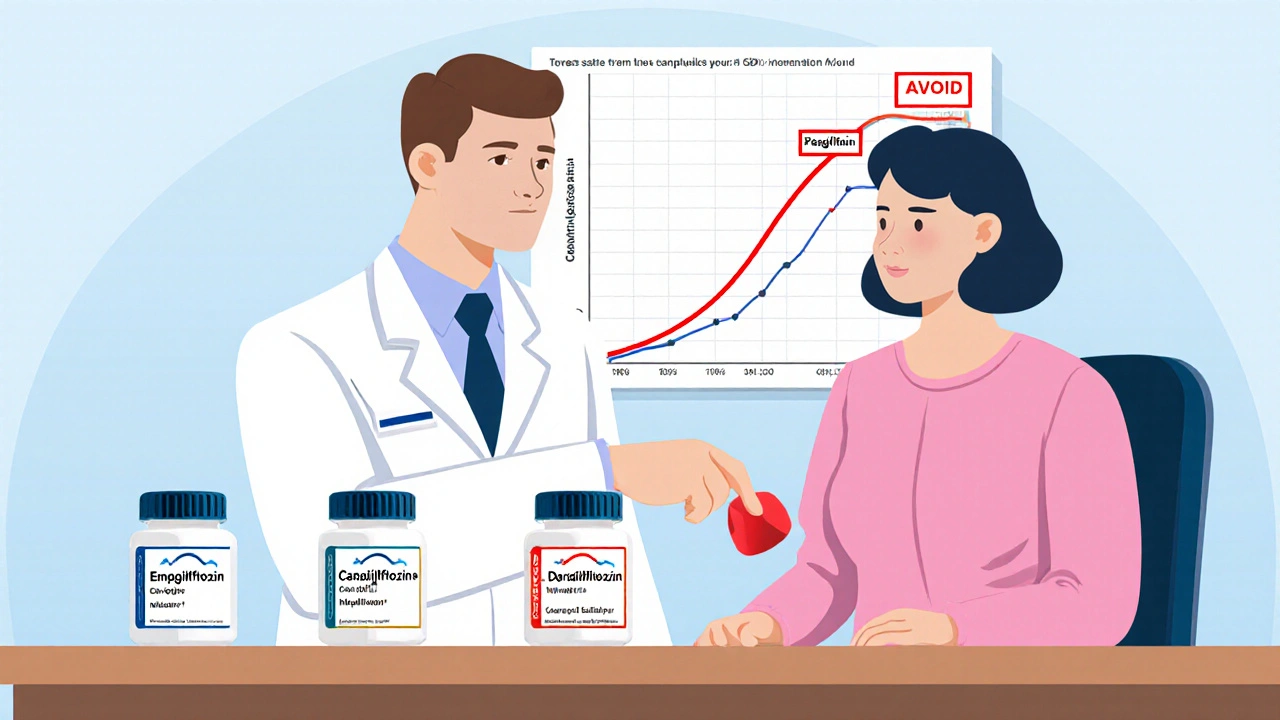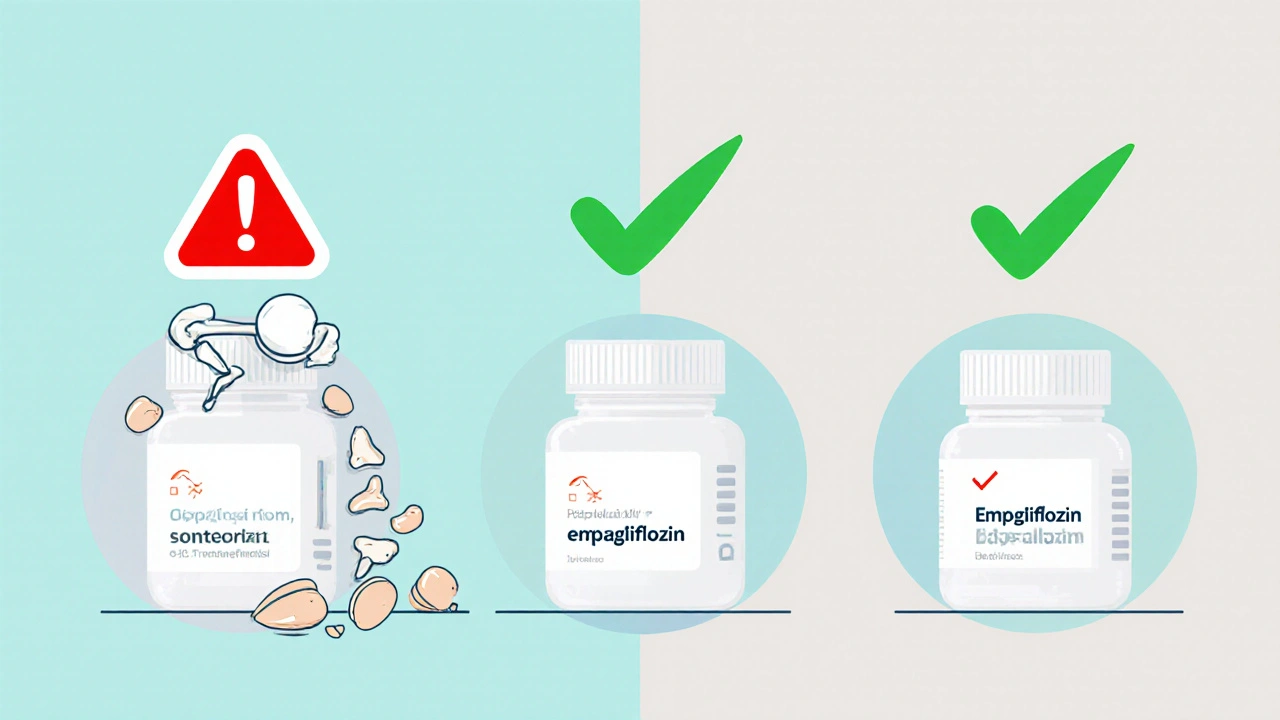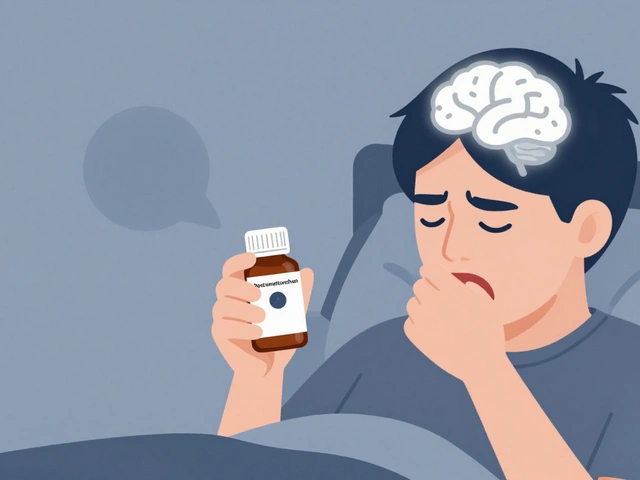SGLT2 Inhibitor Bone Health Risk Calculator
Fracture Risk Assessment
This tool helps you understand your individual fracture risk when considering SGLT2 inhibitors based on your specific health factors.
Your Results
Enter your information above to see your individual fracture risk assessment.
When you're managing type 2 diabetes, the goal isn't just to lower blood sugar-it's to protect your whole body. That's why SGLT2 inhibitors became so popular. These drugs, like canagliflozin, empagliflozin, and dapagliflozin, help your kidneys flush out extra sugar through urine. But in the last decade, a quiet concern has grown: could they be hurting your bones?
Not All SGLT2 Inhibitors Are the Same
It's easy to think of SGLT2 inhibitors as one group. They're all in the same class, after all. But the data tells a different story. The first big red flag came in 2015, when the CANVAS trial showed people taking canagliflozin had a 26% higher risk of fractures compared to placebo. That wasn't a small bump-it was enough for the FDA to issue a formal warning in 2016. The fractures weren't from car crashes or sports injuries. They happened after simple falls-stepping off a curb, slipping in the shower, tripping over a rug.Then came the other drugs. Empagliflozin (Jardiance) and dapagliflozin (Farxiga) didn't show the same pattern. Large trials like EMPA-REG OUTCOME and DECLARE-TIMI 58 found no increased fracture risk. A 2023 meta-analysis of 27 studies involving over 20,000 patients found the overall risk was essentially the same as placebo-1.02 times higher, which is statistically meaningless. The difference? It's not the class. It's the drug.
Why Does Canagliflozin Stand Out?
So why does canagliflozin seem to be the problem child? It's not one thing-it's a mix. First, it causes more bone mineral density loss. In a two-year FDA-mandated trial, patients on canagliflozin lost 0.92% of bone density at the hip and 1.04% at the spine. Placebo users lost less than half that. That’s not a lot in absolute terms, but for someone already at risk, it’s enough to tip the scale.Canagliflozin also lowers estrogen levels-by as much as 9.2% in women taking the 300 mg dose. Estrogen helps keep bones strong. Less of it means faster bone breakdown. It also causes more phosphate loss in urine, which triggers the body to release hormones that pull calcium out of bones. And while all SGLT2 inhibitors can cause dizziness or low blood pressure when standing up (postural hypotension), canagliflozin has the highest reported rates-up to 1% of users. That means more falls.
Weight loss, which everyone likes, might also play a role. Losing 2-4 kg sounds harmless, but your bones respond to that change. Studies show weight loss triggers bone resorption markers. But here’s the twist: weight loss only explains about 3% of the bone density drop. So something else is going on.
Who Should Be Worried?
If you're a healthy 55-year-old with type 2 diabetes and no history of fractures, your risk is low-even with canagliflozin. But if you're older, female, have osteoporosis (T-score ≤ -2.5), or have already broken a bone, the picture changes. The American Association of Clinical Endocrinologists (AACE) says: don't start canagliflozin in these patients. The American Geriatrics Society’s Beers Criteria (2023) even calls it a "potentially inappropriate medication" for older adults with osteoporosis or prior fractures.Other SGLT2 inhibitors? No such warning. Endocrinologists surveyed in 2022 showed clear patterns: 82% avoided canagliflozin in osteoporosis patients, but only 34% had the same hesitation with dapagliflozin. That’s not fear-it’s data-driven caution.
What Do the Experts Really Say?
There’s no single voice here, but the tide is turning. A 2023 study in the Journal of Parathyroid Disease, analyzing real-world data from over 100,000 patients, found no link between SGLT2 inhibitors and fractures-except for canagliflozin. The lead author said the concerns had been "largely overstated." That’s encouraging. But Dr. Robert Heaney, a leading bone expert, warns that most trials are too short. Fractures happen slowly. We might be missing the long-term signal.The FDA hasn't changed its stance since 2018. They still only flag canagliflozin. The European Medicines Agency (EMA) takes a broader view, warning about the whole class-but even they don't single out one drug. Meanwhile, the American Diabetes Association updated its 2023 guidelines to say: "SGLT2 inhibitors as a class do not appear to increase fracture risk, though canagliflozin specifically has shown modest increases in some studies."
What Should You Do?
If you're considering an SGLT2 inhibitor, here’s what to ask your doctor:- Have I had any fractures before? If yes, avoid canagliflozin.
- Do I have osteoporosis? Get a DXA scan before starting any SGLT2 inhibitor.
- Am I over 65? If so, and I'm on canagliflozin, ask if switching is an option.
- Do I get dizzy when I stand up? That’s a red flag for falls.
- Am I on other medications that weaken bones? Steroids, proton pump inhibitors, or anticonvulsants add to the risk.
Don’t panic if you're already on canagliflozin. If you haven’t had a fracture and your bone density is normal, you’re likely fine. But if you’ve fallen twice in the last year, or your T-score is below -2.0, it’s time to talk about alternatives.
What Are the Alternatives?
You don’t have to give up on the benefits of SGLT2 inhibitors. Empagliflozin and dapagliflozin offer the same heart and kidney protection without the bone risk. GLP-1 receptor agonists like semaglutide (Wegovy, Ozempic) are another strong option-they help with weight loss, blood sugar, and heart health, and they don’t affect bone density. DPP-4 inhibitors are safer for bone health too, though they’re less effective for weight loss and cardiovascular protection.The bottom line: you can still get the benefits of SGLT2 inhibitors without the risk. It just means choosing the right one.

Monitoring Bone Health While on SGLT2 Inhibitors
If you're on any SGLT2 inhibitor, especially canagliflozin, your doctor should track your bone health. That doesn’t mean yearly scans for everyone. But if you have two or more risk factors-age over 65, low body weight, prior fracture, steroid use, or family history of hip fracture-a DXA scan every 2-3 years makes sense.Calcium and vitamin D intake matters too. Most adults need 1,200 mg of calcium and 800-1,000 IU of vitamin D daily. If you’re not getting that from food or supplements, your bones will pay the price-no matter which drug you’re on.
Balance and strength training are just as important. Simple exercises like heel raises, standing on one foot, and tai chi reduce fall risk more than any supplement. And if you’re using a cane or walker, make sure it’s the right fit. Falls aren’t accidents-they’re preventable.
The Bigger Picture
It’s easy to get scared by headlines. "Diabetes drug linked to broken bones!" But the truth is more nuanced. For most people, the benefits of SGLT2 inhibitors-fewer heart attacks, less kidney damage, better blood sugar control-far outweigh the risks. But for a small group, canagliflozin is a bad fit.Doctors are getting better at telling the difference. Prescriptions for canagliflozin dropped 22% in the U.S. between 2017 and 2022. Meanwhile, empagliflozin and dapagliflozin prescriptions rose by over 40%. That’s not because of marketing. It’s because doctors are listening to the data.
Your bones don’t care about drug names. They care about your weight, your balance, your calcium, your history, and your choices. SGLT2 inhibitors aren’t the enemy. But choosing the wrong one, without checking your bone health, could be.
Do SGLT2 inhibitors cause bone fractures?
Not all of them. Canagliflozin has been linked to a modest increase in fracture risk, especially in older adults or those with osteoporosis. Empagliflozin and dapagliflozin have not shown the same risk in large studies. The overall class risk is low, but canagliflozin stands out.
Is it safe to take canagliflozin if I have osteoporosis?
No. Major guidelines from the American Association of Clinical Endocrinologists and the American Geriatrics Society recommend avoiding canagliflozin in patients with osteoporosis or a prior fracture. Other SGLT2 inhibitors like empagliflozin or dapagliflozin are safer options.
Should I get a bone density scan before starting an SGLT2 inhibitor?
If you're over 65, have had a fracture, have low body weight, or are on steroids, yes. A DXA scan is recommended before starting canagliflozin. For other SGLT2 inhibitors, it's optional unless you have multiple risk factors.
Can I switch from canagliflozin to another SGLT2 inhibitor?
Yes, and many doctors recommend it if you're at risk for fractures. Empagliflozin and dapagliflozin offer the same heart and kidney benefits without the bone risk. Switching is safe and often improves long-term safety.
Do SGLT2 inhibitors affect men and women differently?
Yes. Women taking canagliflozin showed a 9.2% drop in estradiol levels in clinical trials, which may contribute to bone loss. Postmenopausal women are at higher risk overall. Men are less affected hormonally, but fall risk from dizziness still applies.
Are there other diabetes drugs that are safer for bones?
Yes. GLP-1 receptor agonists like semaglutide and DPP-4 inhibitors like sitagliptin have no known negative effects on bone density. They’re excellent alternatives, especially for patients with osteoporosis or high fall risk.
How do I reduce my risk of falling while on these medications?
Get your vision checked, remove tripping hazards at home, use a cane if needed, and do balance exercises like tai chi or heel-to-toe walking. Stay hydrated and avoid standing up too quickly. If you feel dizzy, tell your doctor-your dose may need adjusting.
Does taking calcium and vitamin D help protect bones on SGLT2 inhibitors?
Yes. While they won’t fully offset the effects of canagliflozin, adequate calcium (1,200 mg/day) and vitamin D (800-1,000 IU/day) are essential for bone strength in everyone, especially those on diabetes medications that affect bone metabolism.







Canagliflozin wrecked my grandma’s hips. She was on it for 8 months, fell once in the shower, and broke her femur. No other meds did that. Switched to Jardiance-she’s walking again.
so like… i get that canagliflozin is sketchy for bones, but why does everyone act like the other SGLT2s are magic? my doc just shrugged and said ‘all drugs have side effects’… but i’m scared to even start one now. like, what if i’m the one who gets the slow-mo fracture?
Anyone else notice how the FDA only flagged canagliflozin but the EMA went full panic mode on the whole class? Feels like politics, not science.
Actually, the 2023 meta-analysis you cited had a 1.02 odds ratio with a 95% CI of 0.91–1.15, which means it’s not statistically significant-but you’re ignoring the subgroup analysis where canagliflozin showed 1.26 (1.09–1.45). That’s not noise. That’s signal.
Let’s be real-this whole post is a marketing pamphlet disguised as medical advice. Canagliflozin’s fracture risk? Minor. The real issue is that pharma companies spent $2 billion on Jardiance ads while burying the cana data. You think doctors are making choices based on science? Nah. They’re making choices based on reps bringing free coffee.
Just had my DXA scan-T-score -2.3. Doc switched me from canagliflozin to semaglutide last week. Lost 12 lbs, HbA1c down to 6.1, and no dizziness. Also started daily balance drills. Life’s better. 😊
So let me get this straight-you’re telling me the drug that causes the most bone loss is the one that’s still widely prescribed, while the safer ones are cheaper and just as effective? Wow. What a system.
I’m 68, postmenopausal, osteoporotic, and on canagliflozin. My endo said ‘you’re fine’-but I’ve fallen twice this year. I’m switching tomorrow. No more guessing with my bones.
As someone from India where access to DXA scans is limited and vitamin D deficiency is rampant, I see this issue differently. Many patients here are on canagliflozin because it’s cheaper and covered by insurance, but they’re not getting bone density tests or supplements. The real problem isn’t just the drug-it’s the healthcare gap. We need public awareness campaigns, not just guidelines written for affluent Western clinics. If your doctor doesn’t check your vitamin D, they’re not doing their job-regardless of which SGLT2 you’re on.
But… if the mechanism is estrogen suppression, and estrogen is a bone protector, and canagliflozin suppresses it more than the others-then logically, the fracture risk should be higher-yet the trials are underpowered, the follow-up is short, and the real-world data is messy… so is it causation? Or just correlation dressed in p-values? And if it’s the latter… then why are we vilifying one drug and glorifying another with identical pharmacokinetics? Are we not all just… statistically noise?
Our bones aren’t just calcium-they’re stories. They remember every fall, every meal, every pill, every silent morning when you stood up too fast. Canagliflozin doesn’t break bones-it just whispers to them, ‘you’re not safe here.’ The others? They hum a lullaby. And sometimes, that’s all you need to keep standing.
As a clinical pharmacist with 18 years in endocrinology, I’ve reviewed over 400 patient charts on SGLT2 inhibitors. The data is unequivocal: canagliflozin increases fracture risk in patients with T-scores below -2.0, especially women over 65. This is not speculation-it’s evidence-based practice. Guidelines exist for a reason. If your provider prescribes canagliflozin without a DXA scan and risk assessment, they are practicing outside the standard of care. Demand better. Your bones will thank you.
Ugh. Another overhyped ‘study’ from the US. In India, we’ve been using canagliflozin for 10 years and no one’s falling over. It’s the diet, not the drug. You guys are all weak. Fix your vitamin D, stop being lazy, and stop blaming Big Pharma for your frailty.